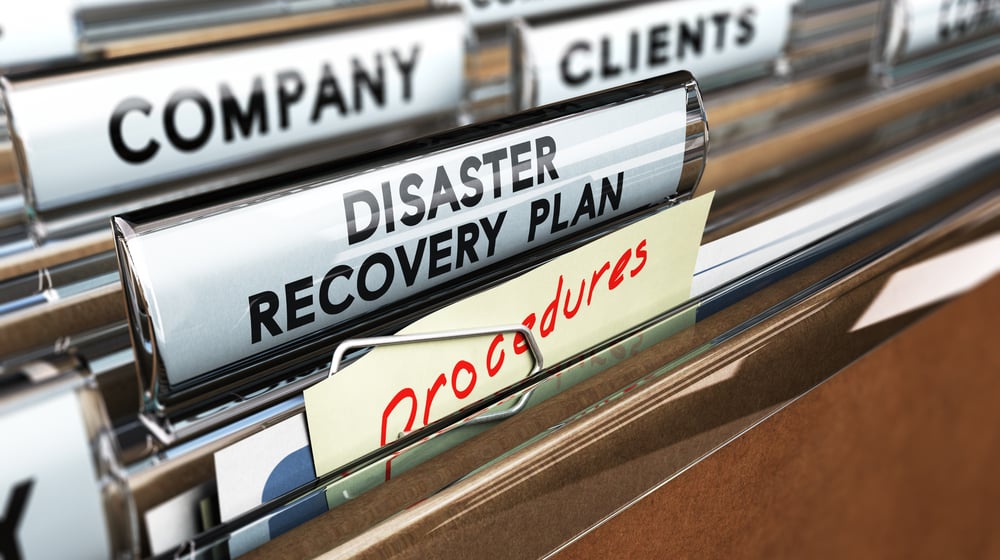||

You close your small business for the day and go home. You come back the next morning, and a leak has caved in the roof and it has fallen on your office server. If you don’t have an IT disaster recovery plan, your day is going to get much worse.
According to the US Small Business Administration (SBA) and its Prepare My Business program, 90 percent of companies fail within a year unless they can resume operations within five days following a disaster. That is an alarming statistic, and one that small businesses should take into consideration as they become more connected and their reliance on digital technology grows. With the right IT disaster recovery plan , even if there is a major disaster, server failure, security breach or data loss, you will be able to restore at the minimum, critical services in the least amount of time.
What is an IT Disaster Recovery Plan?
An IT disaster recovery plan is a process put in place for responding to unforeseen events effecting your data with a documented and structured approach and a clear set of instructions. These instructions include a step-by-step plan designed to greatly minimize the impact of any disaster and to allow your business to swiftly resume operations.
The broader terms business continuity or disaster recovery, generally describe a similar concept. They are procedures allowing you to recover from a disaster quickly so you can continue your business with minimal disruption. However, the IT disaster recovery plan refers specifically to data and other IT operations.
The other two descriptions may also apply to procedures providing for things like replacement for damaged equipment or inventory and even additional part-time or full-time help where needed.
It begins by analyzing the business process and the continuity needs of the company. It requires a business impact analysis and risk analysis to establish the recovery time objective and recovery point objective — both important when setting up the plan.

Analysis
A thorough analysis of the existing digital setup is needed, including hardware, software, data, connectivity, network and more. This, of course, will depend on your business and the industry you happen to be in. The analysis should disclose the resources needed to allow the recovery of business functions and a time objective to recover those functions, as well as recovery point objective after a disaster.
The analysis will also include establishing a disaster-recovery team of employees. These should be employees with the most experience so they can be assigned with contact details and specific tasks. These individuals should be able to prioritize critical business functions and determine the speed of recovery.
Have methods of communication in the event cell towers and internet connections are down. Create a top down list so everyone can go through it until one is found that is working and connects the recovery team.
The next step involves designating a disaster recovery location where critical backup systems can be accessed allowing employees to work. For many small businesses this might be your home, hotel or the home of another business partner.
Have multiple means — phone, email, VOIP, etc. — for contacting everyone involved in the recovery process as well as for other employees, customers, vendors, suppliers, business partners, your insurance company and other resources that might be relevant for your particular business.
Make your customers aware of your emergency plan with alternative ways of getting in touch with you, placing orders, sending payments and even a backup business location. Your website is a great place to have this information.
Back up your digital information in more than one location.
Test your plan at least once a year to integrate new procedures and technologies and to eliminate those that are inefficient or no longer necessary for your business.

Who Should Implement an IT Disaster Recovery Plan?
The answer is every business, but not every business has the resources to implement such a plan with all the bells and whistles. So just having a plan and testing to see that it works no matter how small your business already puts you ahead.
However, for industries that totally rely on digital technology for their day to day operations, it is a must. And it should be as thorough as possible within the limits of your budget. Independent insurance agents, game designers, IT service providers, communications companies and others come to mind as all in need of such a recovery plan. But in reality, it applies to every business that is using computers in their operations.
As far as the reason for implementing an IT disaster recovery plan, it is the same as the reason for buying insurance for your car or home. Having it will give you the peace of mind that you will be able to recover much quicker, not if, but when a disaster eventually strikes.
If the process sounds complicated and you don’t want to implement it yourself, you can have managed business continuity service providers do it for you. The price and services vary greatly, so shop around and choose a company that is able to address the particular requirements of your business.

The Crucial Role of IT Disaster Recovery Planning
You’ve just closed up your small business for the day and head home. The next morning, you return to find that a leak has caused the roof to cave in, damaging your office server. Without a well-structured IT disaster recovery plan, your day is about to take a turn for the worse.
According to the US Small Business Administration (SBA) and its Prepare My Business program, a staggering 90 percent of companies face the risk of failure within a year unless they can swiftly resume operations following a disaster. This statistic is a stark reminder of the importance of disaster preparedness for businesses, especially as they become increasingly reliant on digital technology.
So, what exactly is an IT disaster recovery plan, and why is it essential?
Understanding IT Disaster Recovery Plans
An IT disaster recovery plan is a systematic approach to handling unforeseen events that impact your data, providing you with documented procedures and clear instructions. It serves as your lifeline in the event of disasters, server failures, security breaches, or data losses. This plan is designed to minimize the impact of such events and enable your business to resume critical operations promptly.
While broader terms like “business continuity” or “disaster recovery” encompass similar concepts, an IT disaster recovery plan specifically focuses on safeguarding data and IT operations. It outlines the steps to swiftly recover from disruptions, ensuring minimal business disruption.
Key elements of an effective IT disaster recovery plan include:
1. Business Impact Analysis: Assessing your business processes and continuity requirements, including defining recovery time objectives and recovery point objectives.
2. Analysis: A comprehensive evaluation of your digital infrastructure, covering hardware, software, data, connectivity, and more. This analysis varies depending on your industry and business needs.
3. Disaster-Recovery Team: Assembling a team of experienced employees, assigning roles, and providing contact details. This team prioritizes critical functions and determines recovery speed.
4. Communication Methods: Establishing various communication methods (phone, email, VOIP, etc.) for reaching the recovery team and other stakeholders in case of communication failures.
5. Recovery Location: Designating a recovery location where critical backup systems are accessible, allowing employees to work, which can range from your home to a partner’s place.
6. Customer Awareness: Informing customers of your emergency plan, providing alternative ways to contact you, place orders, make payments, and access your business, potentially through your website.
7. Data Backup: Storing digital information in multiple locations to prevent data loss.
8. Testing: Conducting plan tests annually to integrate new procedures, technologies, and eliminate inefficiencies.
| Key Elements | Description |
|---|---|
| Business Impact Analysis | Assessing your business processes and continuity requirements, including defining recovery time objectives and recovery point objectives. |
| Analysis | A comprehensive evaluation of your digital infrastructure, covering hardware, software, data, connectivity, and more. This analysis varies depending on your industry and business needs. |
| Disaster-Recovery Team | Assembling a team of experienced employees, assigning roles, and providing contact details. This team prioritizes critical functions and determines recovery speed. |
| Communication Methods | Establishing various communication methods (phone, email, VOIP, etc.) for reaching the recovery team and other stakeholders in case of communication failures. |
| Recovery Location | Designating a recovery location where critical backup systems are accessible, allowing employees to work, which can range from your home to a partner's place. |
| Customer Awareness | Informing customers of your emergency plan, providing alternative ways to contact you, place orders, make payments, and access your business, potentially through your website. |
| Data Backup | Storing digital information in multiple locations to prevent data loss. |
| Testing | Conducting plan tests annually to integrate new procedures, technologies, and eliminate inefficiencies. |

Crucial Considerations for Effective Disaster Recovery
- Regular Updates: Keep your disaster recovery plan up-to-date to ensure it remains relevant and effective in the face of evolving technology and threats.
- Employee Training: Provide ongoing training to your employees regarding their roles and responsibilities in disaster recovery. Ensure they understand the plan and can execute it confidently.
- Data Encryption: Implement strong data encryption measures to protect sensitive information. This safeguards data even if it falls into the wrong hands during a disaster.
- Offsite Backups: Store critical data and backups in offsite locations to prevent a single point of failure. This safeguards your information from on-site disasters like fires or floods.
- Vendor Partnerships: Establish relationships with technology vendors and service providers who can offer support during disaster recovery efforts. Ensure they understand your business’s unique requirements.
- Alternative Power Sources: Have backup power sources, such as generators or uninterruptible power supplies (UPS), to keep essential systems running during power outages.
- Incident Response: Develop a comprehensive incident response plan that aligns with your disaster recovery efforts. This ensures a coordinated approach when addressing unexpected events.
- Documentation: Maintain detailed documentation of your IT infrastructure, configurations, and procedures. This documentation is invaluable when rebuilding systems after a disaster.
- Regular Testing: Conduct disaster recovery drills and tests to evaluate the effectiveness of your plan. Identify weaknesses and areas for improvement through these exercises.
- Cybersecurity Measures: Enhance your cybersecurity measures to prevent data breaches and cyberattacks, which can disrupt operations and compromise sensitive data.
- Cloud-Based Solutions: Consider utilizing cloud-based disaster recovery solutions, which offer scalability, redundancy, and flexibility for maintaining critical operations.
- Insurance Coverage: Explore disaster recovery insurance options to financially support recovery efforts in the event of a disaster.
- Collaboration with Authorities: Collaborate with local authorities and emergency services to align your disaster recovery efforts with broader community response plans.
- Post-Recovery Evaluation: After a disaster, conduct a thorough evaluation to identify lessons learned and areas for further improvement in your disaster recovery plan.
| Considerations | Description |
|---|---|
| Regular Updates | Keep your disaster recovery plan up-to-date to ensure it remains relevant and effective in the face of evolving technology and threats. |
| Employee Training | Provide ongoing training to your employees regarding their roles and responsibilities in disaster recovery. Ensure they understand the plan and can execute it confidently. |
| Data Encryption | Implement strong data encryption measures to protect sensitive information. This safeguards data even if it falls into the wrong hands during a disaster. |
| Offsite Backups | Store critical data and backups in offsite locations to prevent a single point of failure. This safeguards your information from on-site disasters like fires or floods. |
| Vendor Partnerships | Establish relationships with technology vendors and service providers who can offer support during disaster recovery efforts. Ensure they understand your business's unique requirements. |
| Alternative Power Sources | Have backup power sources, such as generators or uninterruptible power supplies (UPS), to keep essential systems running during power outages. |
| Incident Response | Develop a comprehensive incident response plan that aligns with your disaster recovery efforts. This ensures a coordinated approach when addressing unexpected events. |
| Documentation | Maintain detailed documentation of your IT infrastructure, configurations, and procedures. This documentation is invaluable when rebuilding systems after a disaster. |
| Regular Testing | Conduct disaster recovery drills and tests to evaluate the effectiveness of your plan. Identify weaknesses and areas for improvement through these exercises. |
| Cybersecurity Measures | Enhance your cybersecurity measures to prevent data breaches and cyberattacks, which can disrupt operations and compromise sensitive data. |
| Cloud-Based Solutions | Consider utilizing cloud-based disaster recovery solutions, which offer scalability, redundancy, and flexibility for maintaining critical operations. |
| Insurance Coverage | Explore disaster recovery insurance options to financially support recovery efforts in the event of a disaster. |
| Collaboration with Authorities | Collaborate with local authorities and emergency services to align your disaster recovery efforts with broader community response plans. |
| Post-Recovery Evaluation | After a disaster, conduct a thorough evaluation to identify lessons learned and areas for further improvement in your disaster recovery plan. |
Conclusion
Businesses, no matter how small or large are now more vulnerable than ever when it comes to cyber attacks. But disasters can also come from human error or nature, and in any event you need systems to deal with those situations and manage them effectively to minimize the negative impact. An IT disaster recovery plan will let you prevent if possible, or at least anticipate and mitigate any business interruptions to your business when a problem occurs.
Disaster Recovery Photo via Shutterstock
This article, "What is an IT Disaster Recovery Plan and Why Does Your Small Business Need One Now?" was first published on Small Business Trends
||----------------------------------------------------------------
By: Michael Guta
Title: What is an IT Disaster Recovery Plan and Why Does Your Small Business Need One Now?
Sourced From: smallbiztrends.com/2023/09/it-disaster-recovery-plan.html
Published Date: Wed, 27 Sep 2023 11:30:00 +0000
Did you miss our previous article...
https://coachingbusinessowners.com/growth/what-is-content-marketing






